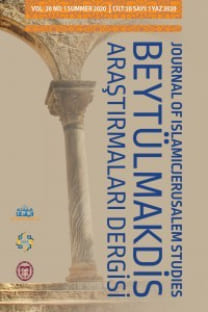Osmanlı Belgelerine Göre Osmanlıların İsra ve Miraç Gecesi Kutlaması
Kudüs, isra ve mi'raç, osmanlılar, Dini Ritüeller, Kandiller
Ottoman Celebrations of the Night Journey and Ascension according to Ottoman Archival Documents and Sources
Bayt al-Maqdis, Religious festivals, Ottomans, Isra, Miraj,
___
- Adem Ceyhan-Bülent Şığva, Hacı İzzet Paşanın Bilinmeyen Bir Eseri: Mi’râc-ı fahr-i Âlem, Eski Türk Edebiyatı Dergisi, cilt 2, sayı:2, 2 ağustos 2019.
- Balikhane Nazırı Ali Riza Bey, Eski Zamanlarda İstanbul Hayatı, Haz. Ali Şükrü Çoruk (İstanbul:Kitabevi Yayınları, 2011).
- BOA,(A,TŞF),1/70; BOA,(ML, EEM),126/25; BOA,(ML, EEM),166/20; BOA,(ML, EEM),166/20; BOA,(ML,EEM),166/20; BOA,(TS, MA,E),541/50; BOA,(TS, MA,E),607/49; BOA,(Y, PRK,ZB), 14/122; BOA,DH.MKT.2067/51; BOA.MB.İ,32/4.
- Ekrem Karadeniz, Türk Musikisinin Nazariye ve esasları (İstanbul: türkiye iş bankası kültür yayınları,2013).
- H.İbrahim Demirkazık, Mecidinin Miraciyesi, Türkish Studies İnternational Periodical For The Languages, Literatue and History of Türkish or Turkic, Volüme 10/8, Spring 2015.
- Halit Ünal, ‘’Berat Gecesi’’, Türkiye Diyanet Vakfı İslam Ansiklopedisi ,Türkiye Diyanet Vakfı, İstanbul 2003.
- M. Baha Tanman, ‘’Kadir Alayı’’ Dünden Bugüne, İstanbul Ansiklopedisi, Türkiye Ekonomik ve Toplumsal Tarih Vakfı, İstanbul 1993. Mehmet Şeker, ‘’Mevlid’’, Türkiye Diyanet Vakfı İslam Ansiklopedisi, İstanbul Türkiye Diyanet Vakfı Yayınları 2003.
- Metin Şerifoğlu, Beşeri Bilimler açısından Bir Arada Yaşama Kültürü ve Biçimleri, (Ankara, Sonçağ Akademi 2020).
- Metin Şerifoğlu, Religious minorities in Jerusalem and their role in the balance of conflict between the Ottoman Empire and European states: A Study through Ottoman Archival Documents (1517-1916), Journal of Islamicjerusalem Studies, 2019, 19 (3).
- Mutasem Almasri, XIX. Yüzyılın İlk Yarısında Kudüs’e gönderilen Surre-i Hümayun, (Yüksek Lisans Tezi), Ondokuz Mayıs Üniversitesi, Sosyal Bilimler Enstitüsü Tarih Anabilim Dalı, Samsun, (2015), YÖK Ulusal Tez Merkezi (Tez No. 425449).
- Özdamar,islambol geleneğinde doğumdan olüme musiki.
- Özge Uslu, 1144 Numaralı Kudüs-i Şerif Surre Defteri (M.1620-21/H.1030), Kırklareli Üniversitesi Sosyal Bilimler, Yüksek Lisans Tezi.
- Şemseddin Sami, Kamus-ı Tuki, Enderun Yayınları ,İstanbul 1989.
- Yılmaz Öztuna, “Kudüs-Suriye ve Filistin”, Osmanlı Devleti Tarihi, C. 2, Ankara: Türk Tarih Kurumu Basımevi, T.C. Kültür Bakanlığı Yayınları / 2069, Yayımlar Dairesi Başkanlığı, Osmanlı Dizisi /1, 1. Baskı, 1998.
- ISSN: 1367-1936
- Yayın Aralığı: Yılda 2 Sayı
- Başlangıç: 1997
- Yayıncı: Beytülmakdis Çalışmaları Vakfı
Hz. Ömer Döneminde (634-644) Beytülmakdis'in Fethi ve İskân
Osmanlı Belgelerine Göre Osmanlıların İsra ve Miraç Gecesi Kutlaması
Kur'an-ı Kerim ve Tefsir Kitaplarında Mescid-i Aksa ve Gece Yolculuğu
Mescid-i Aksa'ya Yönelik Siyonist Strateji
Hz. Ömer Döneminde (634-644) Beytülmakdis'in Fethi ve İskân
Mescid-İ Aksâ’da İbadetin Faziletine Dair Rivayetlerin Değerlendirilmesi
Mescid-i Aksa'ya Yönelik Siyonist Strateji
Hz. Peygamber’in İsrâ ve Mi‘rac’ta Peygamberlerle Görüştüğüne Dair Hadislerin Tahlili
